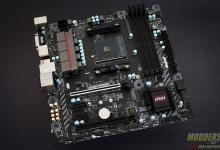MSI Z97 MPower MAX AC Motherboard Review
Test System and Testing Procedures
| Processor | Intel Core i7-4770K (Retail) |
| CPU Cooler |
Noctua NH-D15 with Noctua NT-H1 thermal compound |
| Power Supply |
Enermax Platimax 1000W 80 Plus Platinum PSU |
| Memory | Patriot Viper 3 “Black Mamba” Low Profile 2x8GB DDR3 Memory 2100 MHz CL11 |
| Storage | OCZ Agility 4 256GB SSD (OS), OCZ Vertex 4 256GB SSD (test drive), Vantec NexStar (USB 3.0 enclosure). |
| Graphics | Gigabyte GeForce GTX 770 WindForce OC |
| Drivers | 0406 BIOS, Intel Chipset Driver 10.0.3, NVIDIA 335.23 WHQL drivers. |
| Motherboards | MSI Z97 Mpower MAX AC, ASUS Z97-A, ASUS Z87 Maximus VI Gene |
| Router | Cisco E3200 stock firmware with 2x 6ft Cat5E cables for network testing |
| Operating System | Windows 7 x64 Ultimate SP-1 with latest patches and updates |
Latest working BIOS, updates and drivers were used at the time of the review. Each test was conducted at least three times for accuracy.
Comparison benchmarks in this review are shown between the stock performance, Auto-OC Genie gear 2 performance and manual multiplier overclock of 4.5GHz at 1.28Vcore. This is the maximum overclock achievable on this specific chip on a tower air cooler without throttling under load (under AIDA64 stability test) although it can safely boot up to 4.7GHz with 1.375Vcore. This will also serve as a baseline OC test for cross comparison with other Z97 motherboards down the road.
Tests conducted are separated in three sections: System benchmarks (CPU benchmarks, memory tests, compression benchmarks, media encoding and 3D rendering tests), Subsystem testing (storage, network and audio performance tests), and Gaming Benchmarks (semi-synthetic and real gameplay tests).
System Benchmarks
- wPrime 1.55 32M
- Aida64 Engineer 4.30.2900
- CineBench R15
- PCMark 8 v2.0.228
- WinRAR 5.01
- Handbrake 0.9.9
- x264 FHD 1.0.1
Subsystem Testing
- CrystalDisk Mark for SATA and USB tests
- DPC Latency
- Rightmark Audio Analyzer 6.4.0
- Passmark Performance Test 8.0 – Network Speed Graph
- JPerf 2.0.2
- LAN Speed Test 3.4
Gaming Benchmarks
- 3DMark11 v1.0.132 – Performance and Extreme Preset
- 3DMark (Firestrike test) v1.2.362 – Default Preset
- Tomb Raider – Built-in Benchmark, Low preset on 800×600
- Bioshock Infinite – Built-in Benchmark, Low preset on 640×480
- Sleeping Dogs – Built-in Benchmark, Low preset on 640×480









Good job, liked the attention to detail in your review like the electronic components used, allost noone is doing that these days they are most show off marketing than proper reviews. Thx
Thank you very much for reading. We are always trying to improve our reviews so reader feedback is always welcome. Cheers, –Ron
Great review!, love that you put time into looking what the power delivery system is on this board. They downgraded from the 20 to 12 and changed the components of it, my question is; Is this worse or better than the old power delivery system of the Z87 MPOWER (MAX)?
Hello, thanks for reading. I am fairly conservative when it comes to economics and design so I don’t fault them completely for doing that. Also, MSI is not the only one who scaled back with the design on their boards, which I think is much efficient anyway given current and upcoming CPUs. Hybrid plus less capacitors understandably is harder to accept after seeing the last model but I have a feeling we will see less and less monster VRMs from all manufacturers. I am not an LN2 overclocker so unfortunately I cannot speak with authority on how grossly this is affected but on air, I don’t think it is an issue IMO. The Z87 Mpower MAX AC is still the better deal of the two currently ($239 on NewEgg) hence I did not give the Z97 version an Editor’s Choice award.
Technically is a kinda of an upgrade since previous generation used a 5 true phases design with quadruples (5×4=20 hybrid phase design) and it was controlled by a digital high quality IR3563B PWM, now they use 6 true phases with doublers/drivers package (6×2=12 hybrid phase design) but with a ISL6388 PWM witch is a new product with no much info about it and products from ISL usually are hybrid analog/digital controler witch is not better than fully digital and for that is also a kinda of downgrade but still needs confirmation. The rest of the components mosfets and inductors seems to be as equal quality as from previous generation. In real world this only appears to affect price that seems pretty good for the features and power delivery is more efficient no doubt on that. MSI is pretty solid manufacturer and a lot bigger than most people think.
It seems to be that ISL6388 is Intersil’s first fully digital controller. I have no clue if it is in indeed an upgrade.
Is there any difference on mpower and mpower max? For a average game/media use? maybe some slight overclocking too? Hows the PWM or such compared to each other?
The PWM design is the same, judging by photos from XFastest’s Review: http://www.xfastest.com/thread-135126-1-1.html
Looks like the difference is just a few features: fewer USB 2.0 and 3.0, lack of fixed MOSFET heatsink barbs, WiFi, e-SATA and additional HDMI for Intel graphics.
I hope this won’t go unnoticed
On the Intel Chipset heatsink, with the big M, is that thermal paste? Or is it some kind of thermal compound?
It is solid (albeit soft), flat and very thin tape at room temperature. It is closer to thermal compound in terms of moisture than the drier pink thermal tape used on other chipset heatsinks which leaves harder to remove residue (ASUS Z87 RoG chipsets).
Oh, good. If i take off the heatsink, do i have to replace or change it? I intend to paint the heatsink, but i dont know what to do with the thermal compound/pads.
You can scrape it off completely and just replace it with thermal paste or a thin thermal pad. The chipset itself has a very low TDP ~5W so cooling it is not really going to be difficult.